This post may contain affiliate links to tours and hotels. These help us earn a small commission at no additional charge to you.
South Korea’s most idyllic island getaway, Jeju Island is a popular holiday spot for both domestic and international tourists.
A volcanic island famous for its beautiful beaches and lush tropical landscapes, there are lots of things to do on Jeju Island (including meeting Jeju’s historic Haenyeo elderly women divers).

Given the warm weather, Jeju Island has so many fine, fresh foods to try. Enjoy peanut ice-cream, Jeju black pork, tasty Hallabong tangarines, freshly caught seafood and moorish matcha green – a culinary gem!
Better yet, Jeju Island has so many diverse natural landscapes to enjoy from underground lava tubes and black sand beaches to historical forests – plus quirky stone statues across the islands.
From Sunrise Peak to wonderful waterfalls, here is our guide to the best things to do in Jeju Island, South Korea.

Table of Contents
Getting To Jeju Island, South Korea
Fun fact – the route between Jeju Island and Seoul is said to be the busiest air route in the world.
There are dozens of flights between Seoul Gimpo Airport to Jeju Island daily and over 420 flights per week. This means the fare between Seoul and Jeju is pretty inexpensive.
You can also fly directly to Jeju from Busan, Gwangju, Cheongju, Daegu and many other South Korean cities.
Direct international flights to Jeju Island can be taken from Taiwan, China and Japan. Most international flights to Jeju will be via Seoul.

You might like – the 85+ best things to do in Seoul >
How to get around Jeju Island/ Public transport
Most visitors to Jeju Island will likely have to rely on buses or taxis as there is no train or Subway system on Jeju Island.
Taxis for small distances on Jeju Island are relatively inexpensive (expect to pay 10,000 Won for a 15 minute journey) but larger distances between coasts can be costly.
The best way to get around Jeju Island by public transport is to download the Naver app and use that to work out bus time-tables. Buses on Jeju Island accept cash or T-money cards – they do not accept debit or credit cards. Read more about T-money cards in our guide >
The most common Jeju Island tourist bus routes are:
Jeju Airport Bus Route 600
This goes from Jeju International Airport to Seogwipo via 30 stops including major Jeju City hotels like Lotte and Jeju Sun World.
The Jeju Airport Bus 600 fare starts from 1,100 Won per person for short distances to between 5,000 to 6,000 Won if you want to from go all the way from Jeju International airport to the last bus 600 stop – Seogwipo KAL hotel.
Read more in our guide to using the Jeju Airport Bus 600 >
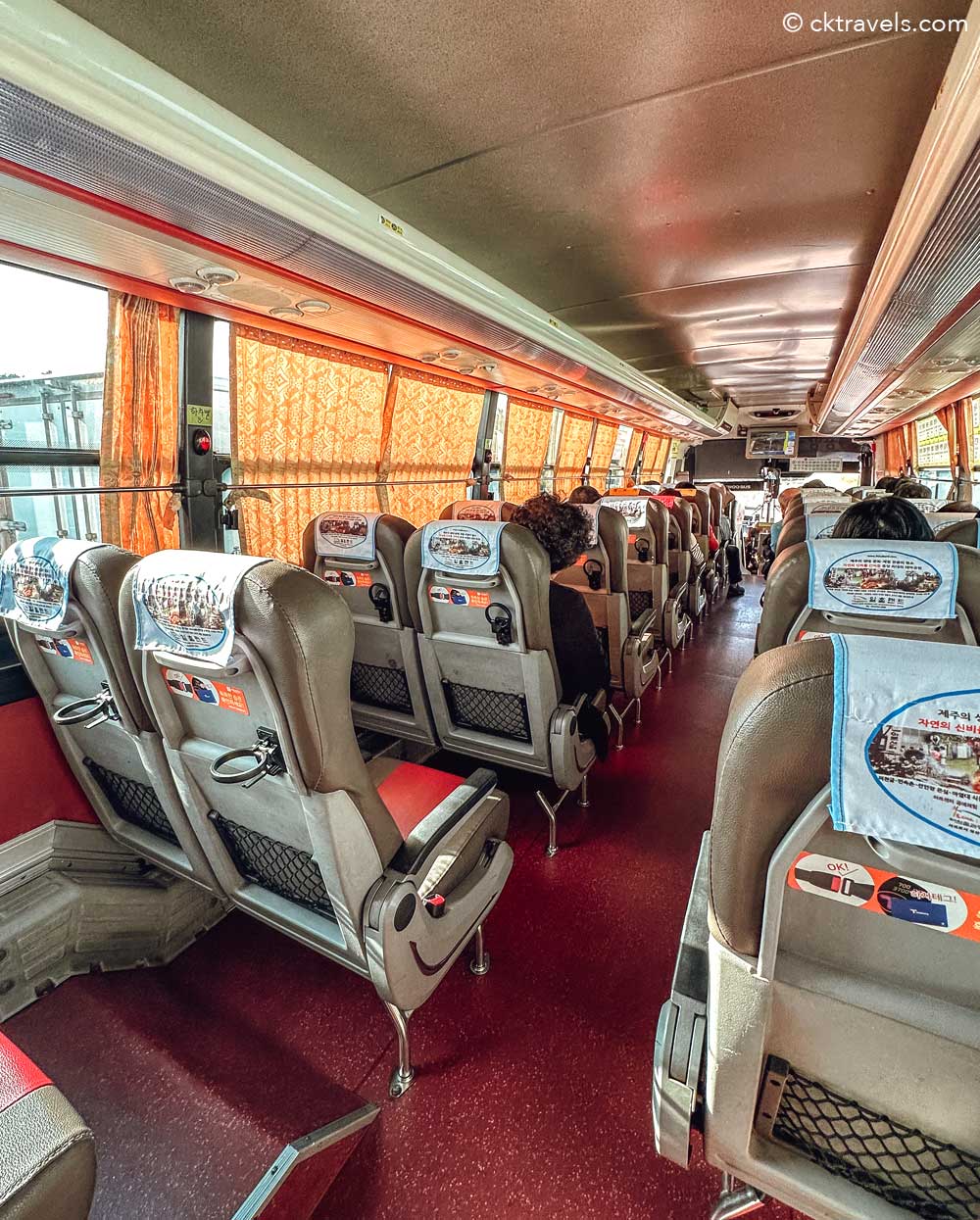
Jeju Tourist Bus Shuttles – Routes 810 and 820
Fares for these shuttles cost 3000 per day and cover many inland tourist attractions.
Jeju Tourist shuttle bus 810 departs from Daecheon Transit Centre and tourist shuttle 820 departs from Donggwang Transit Centre. Both Jeju tourist shuttle buses do a loop.
If you want to cover off all the coast and waterside attractions on Jeju Island, we strongly recommend taking a Jeju Island day tour, given the size of the island.
You might like – Top things to do in Busan >
Jeju Island Recommended Hotels
Given that most tours and day trips generally depart from either Jeju City or Jeju International Airport, we’d suggest the best place to stay on Jeju Island is in Jeju City or the new town area – that is if you don’t have access to a car.
Recommended Jeju City Hotels include:
Jeju Sun Hotel and Casino
We stayed for a week at the 5* Jeju Sun Hotel and Casino and would highly recommend it – we had a recently refurbished room on the 8th floor that was big by South Korean hotel standards.
The room had a partial ocean view and best of all, it was the very first stop on the main Jeju Island 600 Airport Bus (so around a 10 minute bus ride from the airport)
Check our Jeju Sun Hotel and Casino rates here >
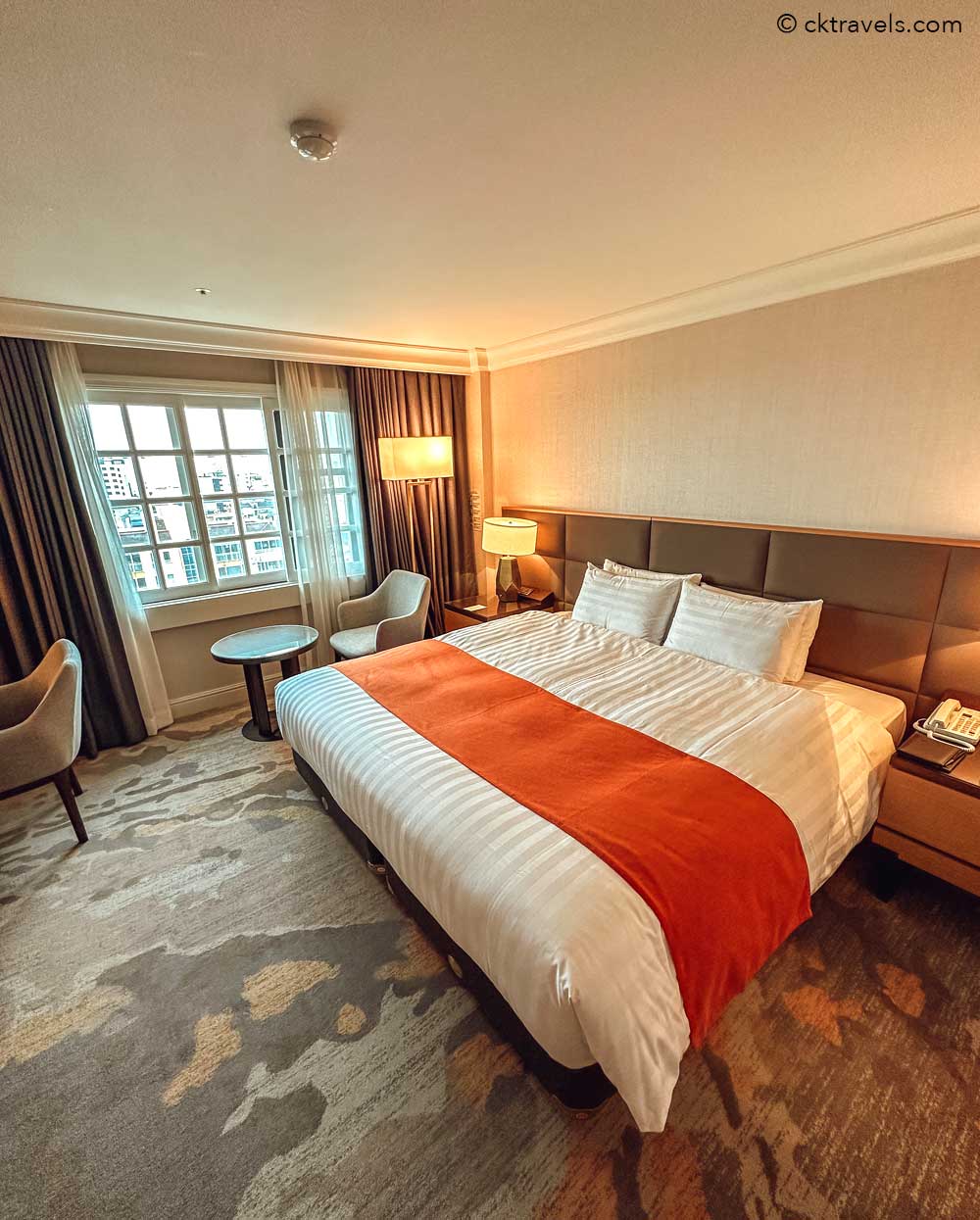
Jeju Grand Hyatt / Jeju Dream Tower
An opulent 5* star Jeju Island hotel with an outdoor (and indoor) pool, 16 restaurants and 2 spas, the Jeju Grand Hyatt Dream Tower also has 38th floor roof top bar with coastal views.
Check out the Jeju Grand Hyatt / Dream Tower rates here >
Things to do on Jeju Island, South Korea
1. Seongsan Ilchulbong AKA Sunrise Peak
For us, easily one of the best things to do in Jeju Island, Seongsan Ilchulbong is a volcanic cone that you walk up plus see from all over the east coast of Jeju.
Also known as Sunrise peak (although it is open all day), Seongsan Ilchulbong offers incredible panoramic views of the ocean and black volcanic cliffs below.

There is a large view platform at the top of Seongsan Ilchulbong and the walk to the top is around 20 minutes; it can be quite steep in places but should be OK for anyone with a good general level of fitness.
There are plenty of shops at the foot to buy cold drinks plus even a couple of enterprising old ladies who have a little stall half way up selling cold water and juices.

If you do want to visit Seongsan Ilchulbong for sunrise itself, there is a really intricate stone carved tablet at the front displaying sunrise times for every day of the month – who needs Google eh?
The Seongsan Ilchulbong Peak entrance fee on Jeju Island is 2000 Korean Won as of October 2023.

You might like – Jeju: UNESCO Sites & Sunrise Peak Hiking Small Group Tour >
2. See the Jeju Haenyeo Women divers
One of the best known aspects of Jeju Island’s incredible heritage and history, Jeju’s Haenyeo Divers are older local women (many of who are in their 70s and 80s) whom dive to the ocean floor to collect seafood.
The Haenyeo lady divers of Jeju island pop their catch into their bright orange floats – often you‘ll hear their high pitched whistles as they resurface known as ‘sumbi sori’.

Akin to traditional mermaids of Jeju Island, there is a real fear that the tradition of elderly Jeju Haenyeo women divers could possibly die off in the next twenty or so years, with no younger female divers to follow.
There are several ways to watch the Jeju Haenyeo Women divers ‘at work’ – the most touristy way is to watch the daily 2pm show in the cove next to Seongsan Ilchulbong. However the elderly Haenyeo divers women don’t always dive here due to strong tides.

Otherwise look out for them at work at the various harbours in Jeju Island. We were lucky to see them at Seogwipo Harbor; there are even several Haenyeo run restaurants on Jeju Island like Haenyeo Hoetjip
Throughout the island, you’ll see various statues of Haenyo Divers, lots of Haenyo souvenirs and ‘merchandise’ plus a dedicated Haenyo Diver museum (more on this later).

Try this – Jeju: Mt. Hallasan Small-Group Nature Hike & Lunch >
3. Cheonjeyeon Waterfalls
This is one whopping waterfall on Jeju Island!
Split into three different sections that are easily accessible by hillside boardwalks, Cheonjeyeon Waterfalls have beautiful blue and turquoise waters (although no swimming is allowed) which are said to have healing properties.

Also known as the ‘The Pond of God,’ the Cheonjeyeon Waterfalls highest cascade is around 30 metres tall and can be enjoyed from a wooden viewing platform (expect to jostle for best position during peak tourist season).
The first waterfall here can only be seen during rainy periods and the whole site is enveloped with evergreen forest.
Admission to Cheonjeyeon Waterfall is 2,500 Korean Won per adult as of October 2023 – Cheonjeyeon Waterfall is also included on most Jeju Island tours that include Southern Jeju.

4. Manjanggul Cave
Going underground, going underground…one of the most unique things to do on Jeju Island, the ancient Manjanggul Caves are one of the largest lava tubes in the world (around 6 miles in length) formed hundreds of thousands of years ago.
The Manjanggul lava cave was formed when a hot lava flow caused thermal erosion which then drains away leaving a huge tunnel underground in the rocks.

Around 1km of the Manjanggul Cave / Lava interior is accessible by foot, with the end point an impressive lava column that is around 8 metres high and the largest lava column in the world. It is so surreal to explore this subterranean lair and tunnel.
As you’d expect, the interior of the Manjanggul Cave / Lava is dark and damp and a little slippery underwood so dress appropriately – it also takes a few moments for your eyes to adjust to the lack of light.
The Manjanggul Lava cave costs 4,000 Korean Won per adult as of October 2023 or is included in most East Jeju Island tours (link)

You might like – South Korean street foods you must try >
5. Jeju Dongmun Traditional Market
One of the best spots on Jeju Island to try traditional dishes like black pork and freshly caught seafood, Jeju Dongmun Traditional Market is both a traditional wet market selling fish galore plus souvenirs, street food and Jeju fruits.
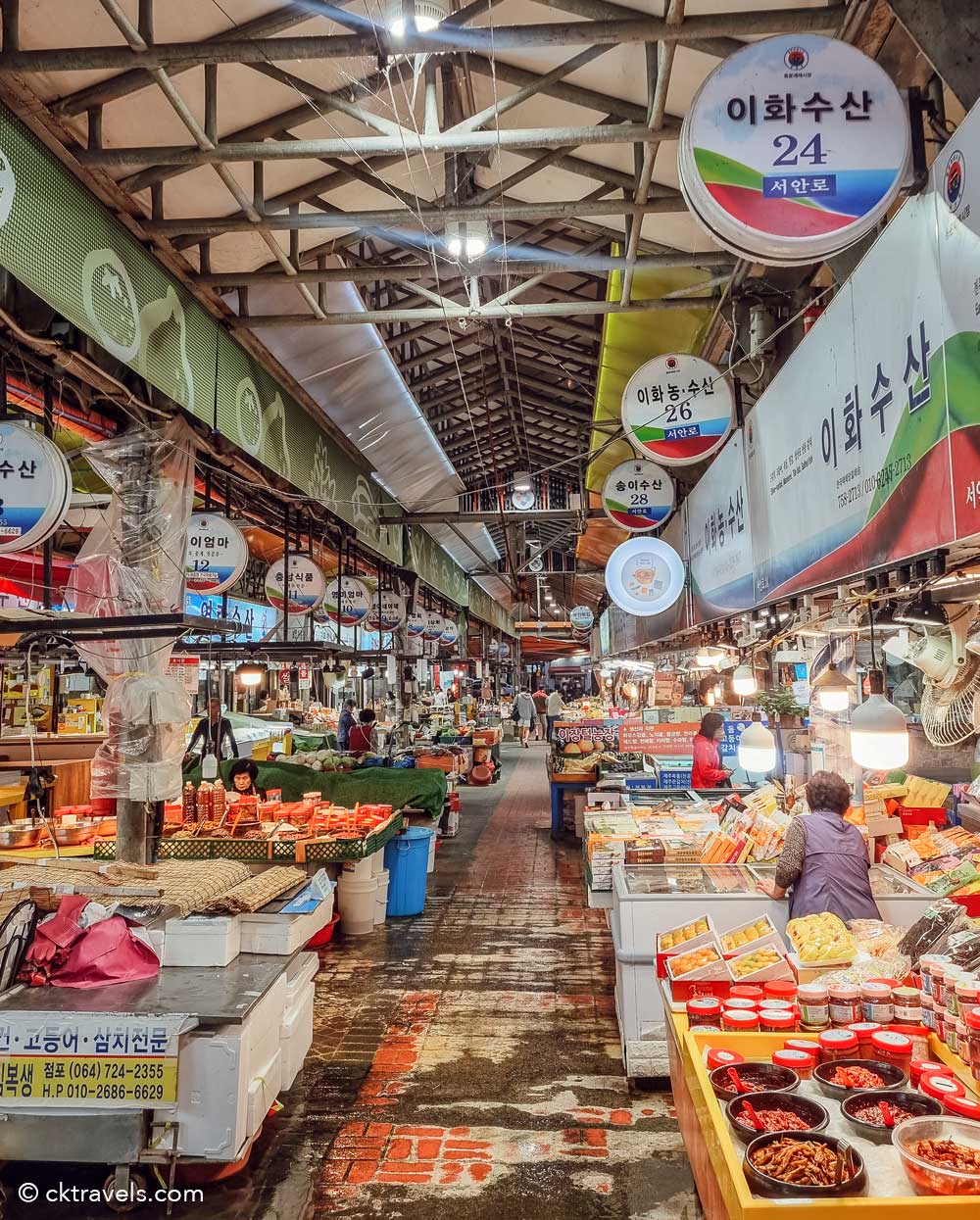
Open daily from 8am to 11pm (although most of the street food stalls only open in the evening), Dongmun Traditional Market is the largest market on Jeju Island and is a joy to walk around – prices seem pretty reasonable compared to dedicated souvenir shops elsewhere on the island.

The street food section at the rear of Jeju Dongmun Night Market is a spectacle with most of the 40 or so food stalls using blow torches to finish off their pork or lobster dishes – literally there are flames everywhere; it looks amazing.
The only downside is that there isn’t really anywhere to sit so you have to enjoy your dishes standing up. Alternatively there are a handful of food court style restaurants on the outer edges including an oden bar that K-pop band Blackpink have dined in.
Read more in our guide to Jeju Dongmun market >


Try this – Jeju K-Pop & K-Drama Day Tour >
6. Eat Jeju Island Black Pork
Jeju Island’s most famous food, Jeju’s Black Pork dishes can be found practically everywhere, in most restaurants, beachside bars and at markets like Dongmen and Seogwipo Olle market.
Jeju Island black pork is said to have a flavourful and unique taste although the pork itself isn’t black in colour; it refers to the black hair of the Jeju Island pigs that bred to produce this dish.

Jeju black pork is some of the best pork in South Korea and is usually prepared using a BBQ over a charcoal fire – or even cooked using a blow torch as witnessed at Dongmun Market.
During our time, we tried everything from Jeju Island black pork dumplings (at a dumpling restaurant by Songaksan Mountain) to Jeju Island Black Pork BBQ stir fry. You can even get Jeju Island black pig souvenirs such as mini statues and fridge magnets.
Try this – customise your own Jeju Island Tour >
7. Songaksan Mountain and Ollie Trail
A free to visit attraction on Jeju Island’s south coast, Songaksan Mountain and Ollie Trail is easily one of the best walks to do on Jeju Island, with stunning coastal views and various look-out points.

The boardwalk paths and concrete road along this volcanic cone make it easily accessible and the whole Ollie Trail loop on Songaksan Mountain takes about an hour to complete.
The peak at the top offers panoramic views of the ocean and south coast including almost 100 volcanic peaks (it is said Songaksan Mountain has a nickname of ‘99 peaks’ because of this view).

Alternatively if you don’t fancy a hike to the peak, for the best views, just head left at the start of the trail for about 15 minutes and head to the observatory lookout before returning the way you came (the views of Gapado Island further on aren’t that impressive compared to other lookouts on Jeju Island).
Along the Ollie Trail hike, there are a few things to do including a small restaurant on the coastal path plus horse rides.
Try this – Aqua Planet Jeju Ticket >
8. Visit a Tea Plantation like Osulloc Green Tea Museum
One Jeju Island thing to do that is definitely our ‘cup of tea’ is a visit to a Jeju Island tea plantation.
The most popular tea plantation on Jeju Island is the Osulloc Green Tea Museum, on the western side of the island which opened in 2001 (it is generally quite busy as many Jeju Island tours visit here).
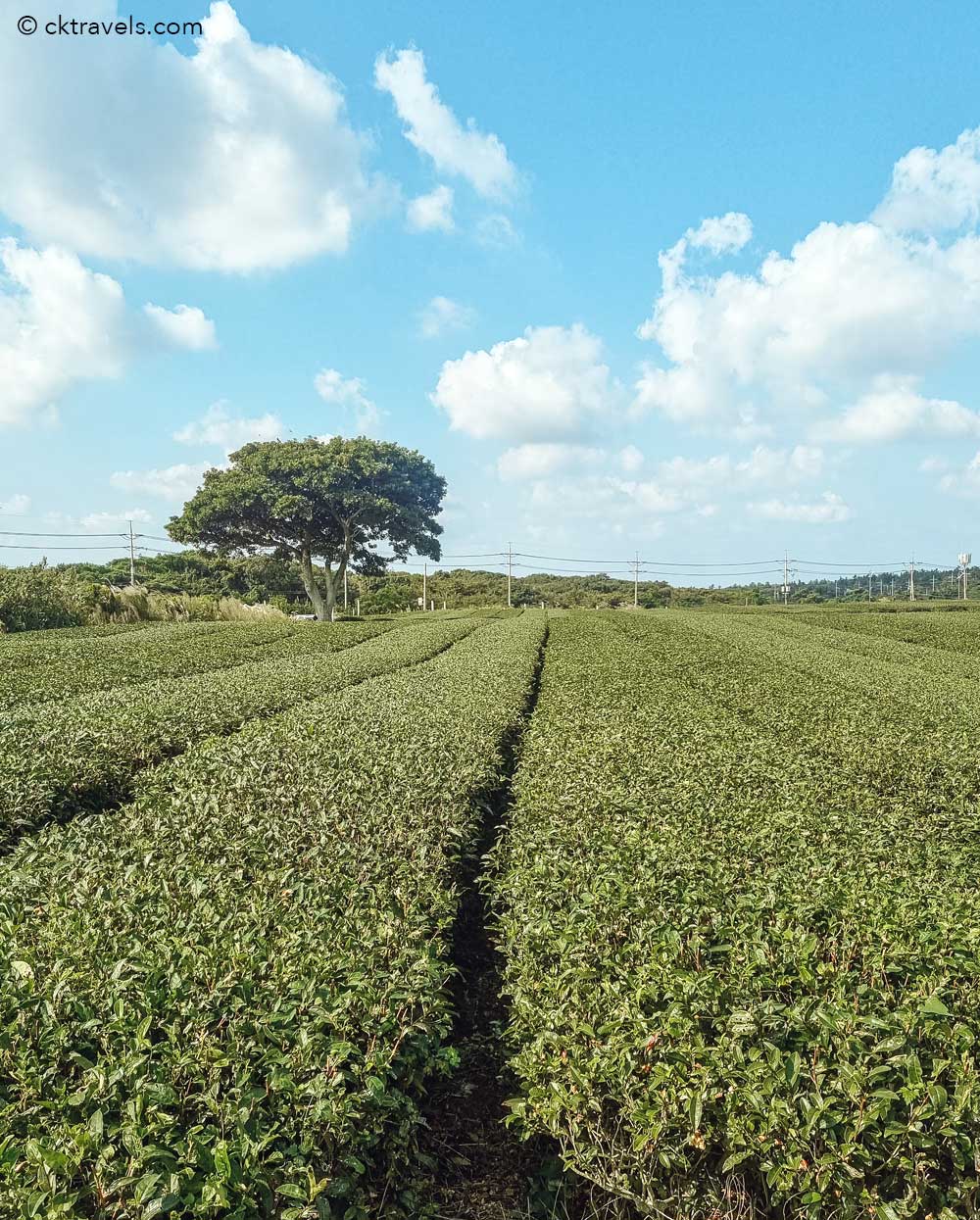
Set in lush gardens and verdant surroundings, whilst the tea plantation out front isn’t much to look at, the interiors and green tea offerings in the Osulloc Green Tea Museum more than make up for it – seriously, this is one good looking cafe and museum.


At the front of the museum, you can learn about the Osulloc green tea making process and even try free samples. However, most people seemed to head straight to the Osulloc Green Tea Museum cafe to try various matcha green tea drinks and cakes – seriously the food and drinking offering here is superb.

We tried a piece of green tea roll cake (so soft and creamy – 6000 Won) plus a Green tea waffle O Fredo / frozen latte (8,000 Won) – delicious!
Whilst at Osulloc Green Tea Museum, also check out the observatory on the second floor plus the lush tea terrace building in the garden outside – there is even an Innisfree K Beauty store located at the back of the museum.
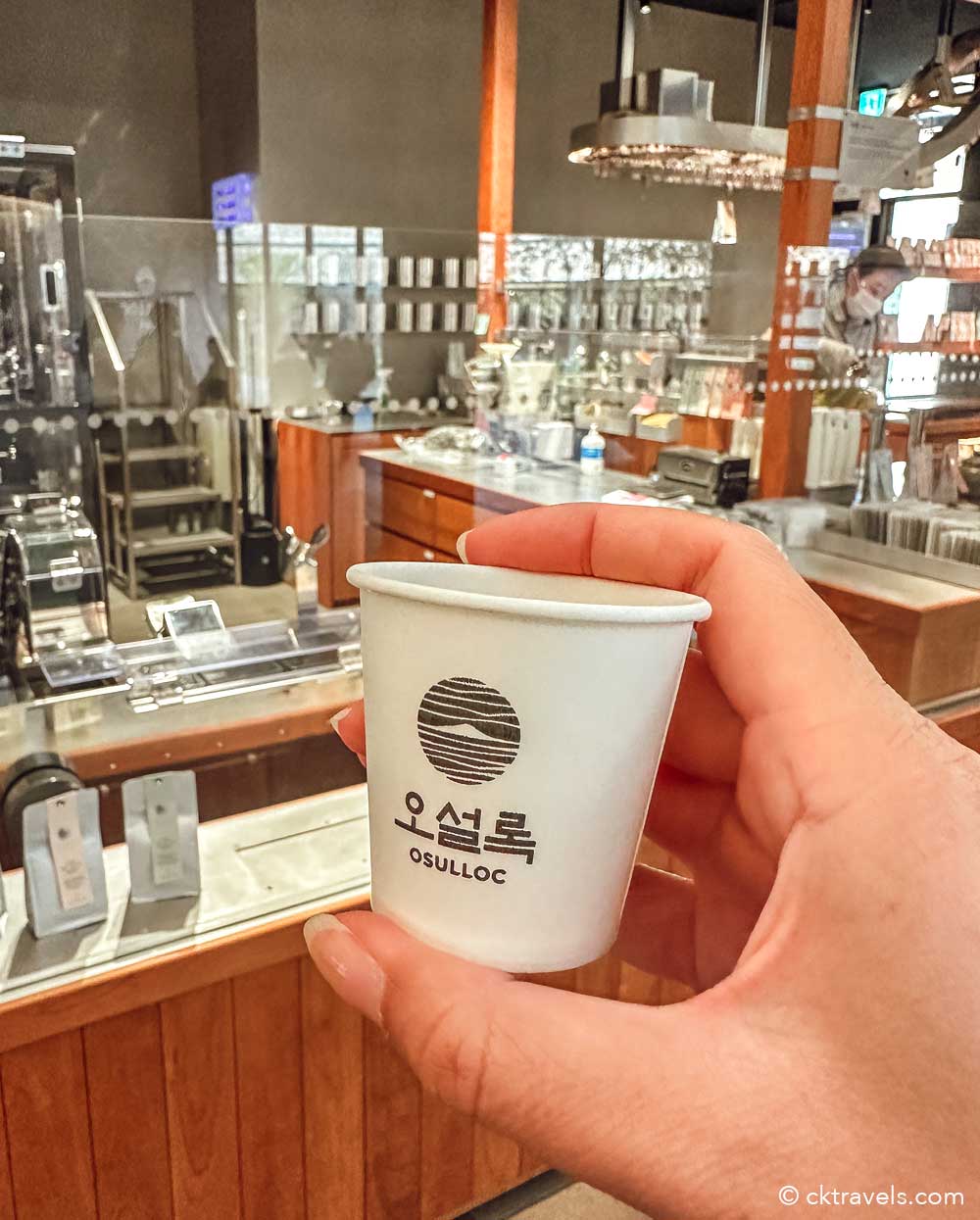
You might like – Guide to South Korea’s HBAF stores and flavours (including Jeju match green tea almonds) >
9. Jusangjeolli Cliff
One of Jeju Island’s best natural wonders and attractions, Jusangjeolli Cliff is a volcanic rock face formed over 150,000 years ago when the molten lava Hallasan Mountain erupted into the Jungmun sea and cooled suddenly.

The unique Jusangjeolli Cliff appearance makes it almost look like rock stairs, similar to Giant’s Causeway in Belfast.
It is easy to visit and just a short walk from the car-park; you can access Jusangjeolli Cliff via a wooden boardwalk and there are several viewing platforms with good photo spots.
We were amazed how blue the waters were and you can also see the various Jeju Island jet boats whizzing around in the sea below.
Jusangjeolli Cliff admission fee is 2,000 Korean Won as of October 2023. It is also included as part of most Jeju Island south coast tours.

Try this – Jeju Sunrise Tour >
10. Gwangchigi Beach
One of the most beautiful beaches on Jeju Island, Gwangchigi Beach offers spectacular views of Seongsan Ilchulbong (Sunrise Peak) and the colourful coastline.
Unlike the white sand beaches of the west coast, this east Jeju Island beach has black sand and had a starring role in the 2015 K drama ‘Warm & Cozy’

At Gwangchigi Beach, there lots of rockpools full of aquatic life plus you might also see Jeju Haenyeo divers at work (alas we didn’t on our visit)
Along Gwangchigi Beach, we also saw several Jeju Island fruit sellers plus galloping horses. According to one of the jockeys, the horses naturally really like Jeju Oranges; unless that is a clever sales pitch arranged between the horse riders and orange sellers!

Try this – Jeju HAMO Sea Walking Activities >
11. Gwakji Beach
The sandy shoreline and crystal blue waters of Gwakji Beach make this one of Jeju Island’s most beautiful beaches. It is lined with bars and cafes so is a nice way to spend a whole day if you want to relax on the beach and grab some lunch (although it can get rather windy).

At Gwakji Beach, volcanic black rocks lie on the white sand as the turquoise waters lap on the shore – as well as the beach, there is a Gwakji Beach outdoor pool and bathing area (separated into a male bathing pool and a female pool).
Also at Gwakji Beach, look out for a rather beautiful stone statue of a Jeju Island Haenyeo female diver, standing on the rocks returning from a successful diving trip at sea – a superb statue and nice reminder of the hard work Haenyeo divers have to endure on the island.


Try this – Jeju 9.81 Go Karting Park >
12. Bijarim Forest
A woodland walk amongst thousands of historic nutmeg trees is a nice way to get close to nature in Jeju Island.
The trees in Bijarim Forest are around 500 to 800 years old and you’ll likely see lots of wildlife including birds, bugs and the occasional snake.

Many locals visit Bijarim Forest in the belief that the trees possess ‘Phytoncide’ which stimulates the immune system in the bodies.
Whilst not exactly picturesque, this is a pleasant way to spend some time in Jeju Island and is a popular activity on many Jeju Island east coast tours.
Admission fees of 3,000 Won per adult apply at Bijarim Forest if you are visiting independently.

We also noticed how popular Bijarim Forest is with nursery groups on Jeju Island – there were literally dozens of school buses and taxis ferrying school kids here (maybe because of the phytoncide angle).
Note if you are driving around Jeju Island, the parking lot at Bijarim Forest can get full very quickly as it is quite small and lots of taxis park here whilst dropping off school groups. So if you want to guarantee a parking space at Bijarim Forest, get here early.
13. Saeyeongyo Bridge
A rather cool looking bridge that connects the mainland (Seogwipo harbor) with Saeseom Island, Saeyeongyo Bridge is free to cross and offers nice views of all the fishing boats in the port.
Located next to Seogwipo Submarine station, Saeyeongyo Bridge was opened in 2009 and was the unusual bridge shape was inspired by ‘Tewu’, Jeju’s traditional wooden sailing boat.

14. Seogwipo Submarine
Jeju Island is renowned for its incredible coastline – there is no better way to get up close underwater than on a trip aboard the Seogwipo Submarine.
Once aboard, dive around 40 metres underwater and see Jeju Island’s abundance of colourful fish, coral reefs and also a sunken ship.
The Seogwipo Submarine on Jeju Island starts from around 65,000 per adult (44,000 Won for children) for a 1 hour trip. Cheaper prices are available online if you book in advance.
15. Saeseom Island AKA Bird’s Island
An uninhabited island just a stone’s throw from Seogwipo‘s main port and accessible by Saeyeongyo Bridge, Saeseom Island is a conservation zone that is home to numerous birds and wildlife.
There is a 1km boardwalk all the way around Saeseom Island with views of the ocean plus photo zones and panoramic lookouts; it even has speakers at the start playing very soothing Korean music (none of your K-Pop here!).
Saeseom Island is free to visit and flat to walk around.
16. Gamble in a casino on Jeju Island
Although gambling and visiting casinos is prohibited in South Korea for Koreans, there are actually around 15 to 20 casinos in South Korea that are open to foreigners only, half of which can be found on Jeju Island.
As of summer 2023, there are 8 casinos on Jeju Island, most of which are located in Jeju City (with Jeju Dream Tower’s new casino opening in 2021).

Unlike say the full on gaming and gambling casino experience in Las Vegas, gambling and casinos on Jeju Island are much more discreet.
We stayed at the Jeju Sun Hotel and Casino Resort whilst in Jeju City and expected the casino element to be full on – instead, it was tucked away on the ground floor and was all creme furnishings.
It also only opened until 10pm each night (so no 24/7 casinos or gambling on Jeju Island) and passports had to be shown on entry as proof of foreign citizenship.
Check out the room rates for Jeju Sun Hotel and Casino Resort or Jeju Dream Tower inside the Grand Hyatt.
16. Camellia Hill Botanical Garden
A gorgeous gem of a green space on Jeju Island, Camellia Hill Botanical Garden is a sprawling year-round arboretum that is home to over 5,000 camellia trees of around 500 different varieties.
As well as a cavalcade of colourful camellia trees, this Jeju arboretum also has wildflowers, ponds, floral plazas and palm trees (you’ll see a lot of these across Jeju Island).
Admission to Camellia Hill Botanical Garden is 10000 Won per adult as of October 2023.
17. Jeju NANTA show
There are few theatre shows to see on Jeju Island at night but perhaps the most famous (and long-running) is the Jeju NANTA theatre show.
This world renowned comedy cooking show has been packing in audiences worldwide since 1997. Possibly the best known Korean theatre show, NANTA Theatre has been performed over 50,000 times in over 60 countries and is a fun mix of slapstick and physical comedy.
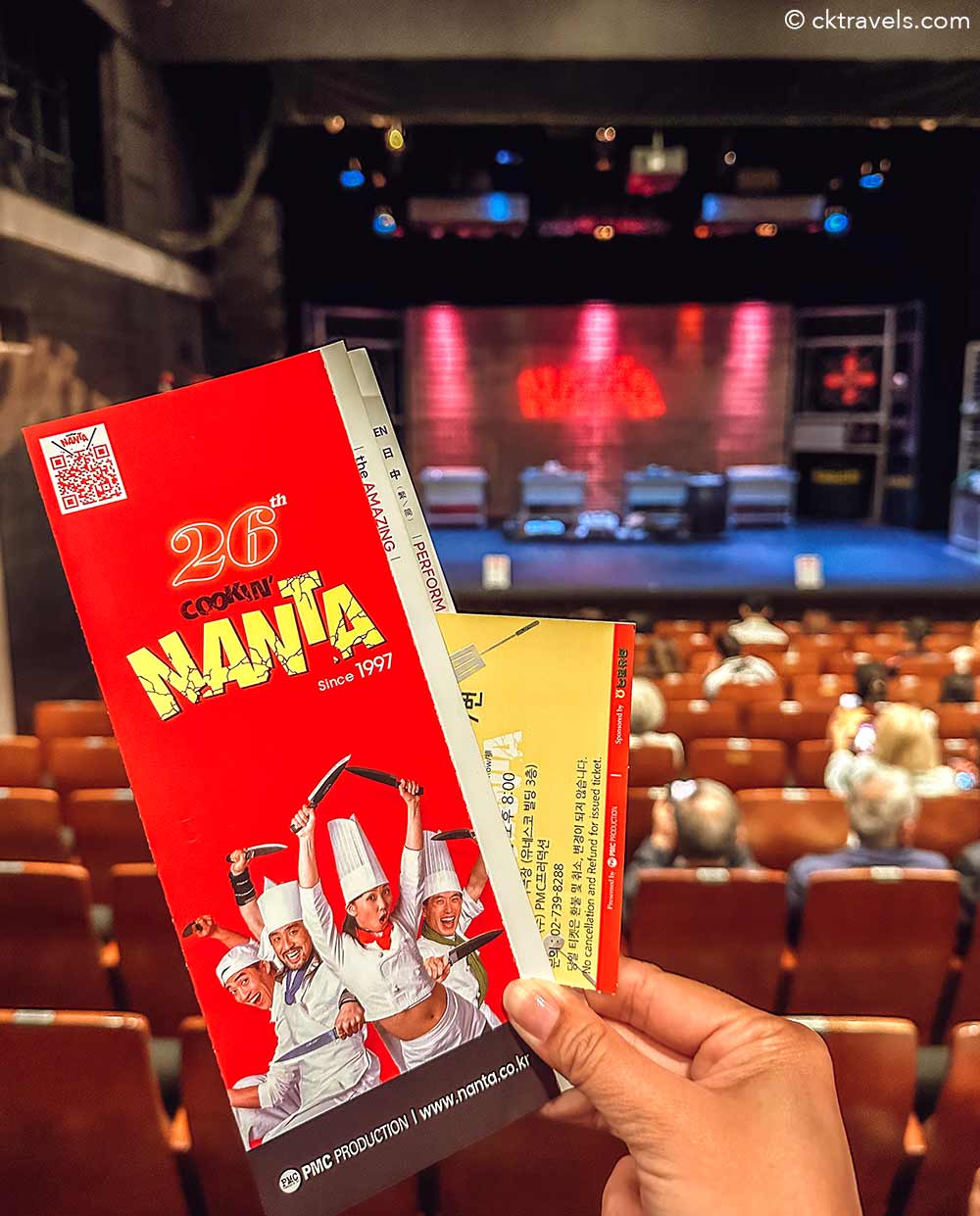
There are very few spoken words used throughout so not understanding Korean (or English) won’t be an issue.
Jeju NANTA Theatre has at least one NANTA performance every day, with daily shows held at 4.30pm (occasionally there is also a second show at 8pm).
We’ve previously seen the NANTA Show in Myeongdong, Seoul and highly recommend it!
Book your Jeju NANTA Show tickets here >

18. Seogwipo Olle Market
One of Jeju Island’s best markets (and also Jeju Island’s largest traditional market), Seogwipo Olle Market is a maze of traditional fruit and veg stalls plus street food stalls (including lots of Jeju Island black pork dishes).


A mix of sit down restaurants and takeaway food stalls, one of Seogwipo Olle Market’s more unique features is the sitting area along a stream inside where you can devour your succulent skewers or juice Jeju oranges.
Open daily until from early morning until 9pm, Seogwipo Olle Market serves as both a Jeju Island night market and traditional market.
It is also a great place to grab fresh oranges, carrots and peanuts (all famous Jeju Island food stuffs) from local farmers and elderly Jeju island citizens).
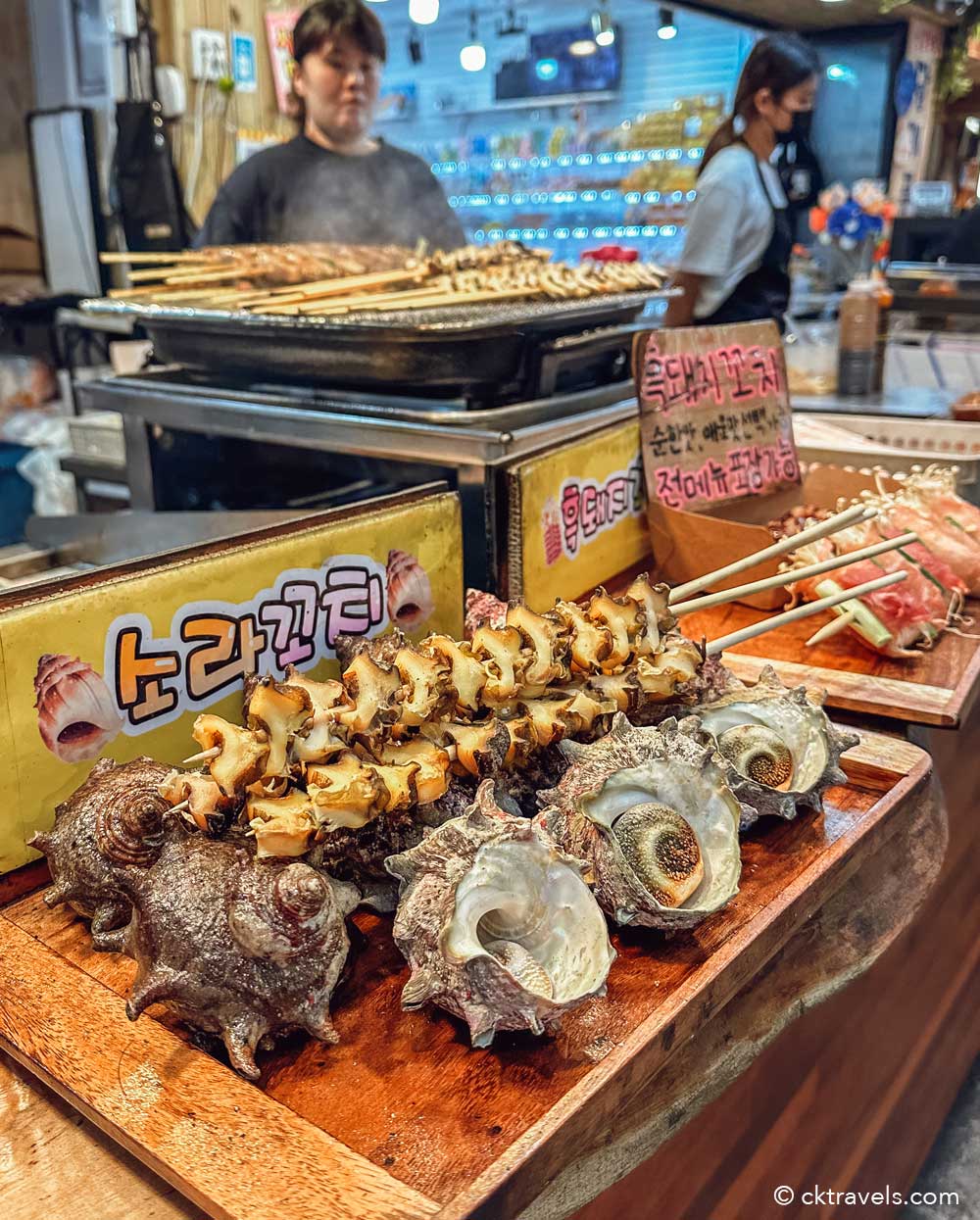
Try this – Jeju Wonderisland Admission Ticket >
19. Cheonjiyeon Waterfall
Close to Seogwipo town centre and not to be confused with the similarly titled Cheonjeyeon Waterfalls (there is one letter difference), Cheonjiyeon Waterfall has one cascade and is around 20 metres high.

Cheonjiyeon Waterfall is the easiest of all the Jeju Island waterfalls to visit – it is a flat walk around about a 5 minute stroll from the car park outside.
Popular with families and the best Jeju Island waterfall to get up close to, Cheonjiyeon Waterfall also has several gift shops and restaurants onsite – we found a really cute gift shop there selling lots of Jeju orange cartoon character merchandise.
Admission to Cheonjiyeon Waterfall costs 2000 per adult as of October 2023.

Join our New 2024 Facebook South Korea Travel Planning and Tips Group!
Need help with your itinerary or have any South Korea related questions? Head on over to our Facebook group!
Click here to join our group >
20. Jeju Island Teddy Bear Museums x 3
Yes, we can hardly ‘bear’ to believe it but there are not one but three teddy bear museums currently on Jeju Island (when on the island, you’ll notice there are quite a few random things to do on Jeju Island).
As of October 2023, the three teddy bear museums on Jeju are the Teddy Bear Museum (the most visited), the Joanne Teddy Bear museum (a collection of Joanne Oh Teddy bears) and the Jeju Teseum, featuring teddy bears from all over the world.
Popular with kids and teddy bear enthusiasts, maybe only visit these teddy bear museums if you are a furry fan or if it is a rainy day on Jeju Island.
21. Eat Jeju Hallabong tangerines or drink juice
Everywhere you go in Jeju Island, you’ll see enterprising locals selling Jeju Island tangerine oranges on the roadside, or on the beach (and even half way up Songaksan Mountain!).

Due to Jeju Islands tropical conditions, it is the perfect place to grow juicy and tasty tangerines – they are used in dozens of products from Jeju Hallabong tangerine juice in ‘Dol hareubang’ shaped containers) through to Jeju Hallabong orange ice-cream or sorbets.
There are several Hallabong tangerine farms on Jeju Island to pick your produce or visit Jeju Markets like Dondeum or Seogwipo Olle Market for a taste of Jeju’s tropical tangerines – even Jeju Island Starbucks have unique Jeju Hallabong dishes that can only be found on the island.


22. Seongeup Folk Village
A traditional Jeju Island homestead that was built in the 19th century and opened up to tourists in the 1970s, Seongeup Folk Village is a throwback to traditional times on Jeju Island, with dozens of stone houses and cottages with thatched roofs.

As well as visiting old out houses and temples, you can take part in traditional hobbies and old time sports like archery or hoop-la plus visit a small scale animal farm.
Seongeup Folk Village still has several hundred residents today and as you wander around the side streets and alleyways, you’ll hear distant voices or Korean radio emanating from the homes.

Seongeup Folk Village is a serene thing to do in Jeju Island but it does feel a little convoluted and a twee tourist trap – for instance, this historic Jeju folk village now even has a bright yellow branch of Paik’s Coffee.
There are also several restaurants where you can try Jeju BBQ Black Pork (nom).
23. Halle Arboretum Night Market
Although a lot smaller than Jeju’s Dongmun Night market and Seogwipo Olle Market, the Halle Arboretum Night Market is a much more picturesque affair, located in a small forest on the edge of the arboretum.
Comprising around 30 stalls, as well as food trucks, there are lots of fairground style attractions popular with families like fishing games or popping balloons (kinda like a circus sideshow).

The Halle Arboretum Night Market setting is spectacular, especially at dusk when the fairly lights strung between the lights twinkle – we also visited this Jeju night market during the autumn (October 2023) so the Halloween theming was cute, especially the huge inflatable ghosts.

Food available included local pork dishes as well as international fare like Vietnamese, Thai, pizzas and burgers. Next door to Halle Arboretum Night Market, you’ll also find the Sumokwon theme park that has immersive games plus ice statues – random!
We also found a really nice bar here that served Jeju Brewery craft beer plus a Jeju black pork sausage (you could get a pint of Jeju Brewing and a black sausage for 10,000 Won).

24. Drink Jeju Brew Beer
Jeju Island is not short on excellent craft beer bars – it is also home to several well known South Korean craft beer breweries including Magpie Brewing and the Jeju Beer Company (both of which are very popular in Seoul).
Magpie Brewery has a large taproom on the north coast whilst Jeju Brewery has a taproom and brewery in Hallim, Jeju City.

You’ll see multiple craft beer bars dotted around Jeju Island, both on the coast and in the cities.
We also really enjoyed a quirky craft beer bar in Jeju City called ‘I Think You Think Too Much’ which served homemade wholewheat pizzas with local and international craft beers.
You might like – the best craft beer bars in Seoul or best craft beer bars in Busan.

25. Hyeopjae Beach
Overlooking Biyangdo Island and offering beautiful coastal views with blue / azure waters, Hyeopjae Beach is a popular spot and great free thing to do in Jeju Island.
You can swim here on calm days or explore the rock pools and look for hermit crabs – if you are more about coffee culture, there are several cafes overlooking Hyeopjae Beach.
You might like – Guide to buying baseball game tickets in Seoul >
26. Mysterious Road (Dokkaebi Road)
One of the more quirky things to do on Jeju Island, Mysterious Road (Dokkaebi Road) is actually a downward-sloping hill that supposedly looks like an incline.
This means it creates an optical illusion that looks like cars and traffic are rolling up a hill – many drivers visit Jeju Island’s Mysterious Road to put their cars in neutral and experience this rather odd road.
Look out for the blue signs when driving to show exactly where it stops and starts. The Mystic Cafe along the same road is also a good spot to enjoy the magical comings and goings of Mysterious Road.
Like this? Check out the Dunedin’s Baldwin Street in New Zealand, the steepest street in the world >
27. Jeju Island Handsome Youngmen Lobster Stall
No, you haven’t read that wrong (and we aren’t that type of site!) – Jeju Island’s latest food attraction and street food story is Dongmun Market’s Handsome Youngmen stall, which specialises in blow torch lobster.

Already amassing over 35k followers on Instagram, the Handsome Youngmen turn up the heat nightly at Dongmun Market, dancing to techno music and delivering smoking hot lobster (literally with a blow torch).
The Handsome Youngmen and their lovely lobster stall are easy to find – just look for the longest queue at the rear of Dongmun Market (or listen for the sound of K-Techno music).
You might like – Guide to going to a South Korea K-League game >
28. Hallim Park
One of Jeju’s most frequented parks, this is kind of a small scale Disneyworld with several attractions like a zoo, caves, amusements, a bird aviary and a traditional Korean Village – there are also gardens to enjoy plus a popular palm tree road.
29. The Seonimgyo / Seonim Bridge
Built in 1984 and essentially a huge arch bridge that spans the river by Cheonjeyeon Waterfall, the red and white Seonim Bridge has nice views from the top plus seven carved nymphs on either side (to represent the Korean folklore tale of the descent of seven beautiful nymphs from heaven).
Included as part of the admission fee to visit the next door three Cheonjeyeon Waterfalls, the bridge is almost 130 metre in length and only accessible by foot – it is also REALLY steep to walk on! Avoid it if you are not a fan of heights.

30. Oedolgae Rock
Found on the south part of Jeju Island, Oedolgae Rock is a naturally occurring attraction and formation that literally translates in Korean as ‘Single Pillar Rock’.
Around 20 metres in height and viewable from a nearby coastal ledge, Oedolgae Rock features on many Jeju Island postcards due to its human like face; various K Dramas have also filmed at this spot including ‘Daejanggeum’.
31. Jeongbang Waterfall
Unlike the other two previously mentioned Jeju Island waterfalls, Jeongbang Waterfall plunges directly into the ocean and is a sublime sight to behold, with steep cliffs and a forest of pine trees as a beautiful backdrop.
Close to Seogwipo city, you can also sometimes see some of the local ladies here setting up a seafood stall – the boardwalk from the carpark to the lower viewing platform takes around 5 minutes to reach.
Try this – Jeju Hanbok Private guide tour & photo session in beautiful Yongduam rock >
32. Jeju Haenyeo Museum
We’ve mentioned you can actually see the Haenyeo divers at ‘work’ in the sea before but if you want to learn more about them, a dedicated Jeju Haenyeo Museum was established around 20 years ago in 2003.

Here, you can watch videos on a large screen but detail the history of the Haenyo plus there are several galleries of Haenyeo artefacts like old diving costumes and recreations of traditional fishing villages.
Also at the Jeju Haenyeo Museum, there is a sculpture park plus we spotted several full size fishing boats on display in the gardens- the top floor of the museum also has an observatory looking out towards the ocean. A small gift shop can be found on the ground floor selling Haenyeo souvenirs.
You might like – Jeju Woman Diver Haenyeo Traditional Clothes Rental >


Try this – Jeju Island Private Taxi Tour : 2 Full days >
33. Snoopy Garden and Hello Kitty World
If you love all things cute and cuddly, you might be excited to hear that two of the world’s most popular cartoon characters have their own theme parks on Jeju.

Jeju Island is home to both the Snoopy Garden (well, Jeju is famous for its ‘Peanuts’ after all), plus the bright pink palace that is the Hello Kitty Island.
Hello Kitty Island promises every visitor ‘One Fine Day’ and has purrfect attractions such as the Hello Kitty History Wall, a Hello Kitty Art Class plus even a Hello Kitty Cafe – or get lost in the Hello Kitty outdoor maze!
As visited by K Pop legends BTS, The Snoopy Garden House features 5 themed halls and 3 outdoor courtyards featuring various Peanuts characters plus 11 themed gardens – afterwards have some Snoopy snacks in the Snoopy Cafe (not just dog biscuits) or enjoy the Snoopy shop.
You can visit the Snoopy Garden as part of the Jeju K-Pop & K-Drama Day Tour >
34. Jeju Island Tours
Getting around Jeju Island by public transport isn’t the easiest of options – it is possible but the island is so spread out that taking the bus from one coast to another can take a couple of hours.
For instance, we got the Jeju Island Airport Express bus 600 from Jeju City to Seogwipo and it took around 30 stops and 1.25 hours between the two.
As such, the best way to see a lot of Jeju Island in a small amount of time is to book on a Jeju Island tour (and most depart from either downtown Jeju City or from Jeju International Airport – so if you want to do Jeju tours, make sure to base yourself in Jeju City or nearby):
Jeju Island Tours on Klook >
Jeju Island Tours in Viator >
Jeju Island Tours on Get Your Guide >

You might like – things to do in Jeonju, South Korea >
35. Jeju Island cruises and sailing trips
There are plenty of ways to hit the waves and water on Jeju Island, including the Seogwipo Ferry Cruise, Jeju Island jet boats, or the HAMO Jet Boat Dolphin Tour.
Another alternative is the Gimnyeong Yacht Cruise Tour in Jeju where you can spot dolphins in their natural surroundings whilst enjoying a beer or glass of wine.
Or check out these top Jeju Cruises & Sailing activities.
36. Makgeolli and Soju Brewing Experience in Jeju
We’ve mentioned all the craft beer breweries in Jeju – if beer isn’t for you, you can learn how to brew South Korea’s Makgeolli and Soju drinks on Jeju Island (tip – best accompanied with Jeju black pork)!
As well as taking home your own Makgeolli brew, a bottle of distilled Soju will be given as a souvenir (although you could always say you made it!)
Afterwards, do a taste test of 6 premium alcoholic drinks made by the brewery, accompanied with Kimchijeon (Kimchi pancake) or Pajeon (green onion pancake) – cheers!
Book your Makgeolli and Soju Brewing Experience in Jeju here >
37. Lee Jung Seop street, Seogwipo
If you are heading to Seogwipo Olle Market from Seogwipo harbour area, make sure you arrive via the Lee Jung Seop Street – this is a cute hill-side street full of craft stores, souvenir shops and coffee shops.
Also on some days (we visited on a Saturday afternoon), independent street traders line either side of Lee Jung Seop street selling their homemade crafts and artisan items.

38. Freddie Mercury Statue on Jeju Island
Here at CK Travels, we like random statues including the Columbo Statue in Budapest – so we are pleased to report that there is a bronze statue of Queen front-man Freddie Mercury on Jeju Island – honestly, we aren’t talking (Radio) Gaga.
Unveiled in 2022 and costing 50 million Won, the Jeju Island Freddie Mercury statue was paid for by a local businessman and is only the second such official Freddie Mercury Statue in the world (the other is in Montreux, Switzerland).
The band Queen OK’d the statue on their first concert in South Korea in 2020 and Sir Brian May, Queen’s guitarist even sent a video message to fans attending the Jeju unveiling.
The Jeju Freddie Mercury statue can be found on a boardwalk on the northern coast near Cafe JJ Grand Bleu and Gwakji Beach.
39. Korean selfie booths
One of the most fun things to do on Jeju at night (or any time of day really), Korean selfie booth stores are dotted all throughout Jeju, mainly in the more populated areas like Jeju City and Seogwipo.

Selfie kiosks are brightly coloured stores on Jeju Island where you can borrow clothes and fun props (like vegetable hats, big sunglasses, animal paw gloves etc) and then pose for selfies or take photos in booths for a small fee.
Often these Korean selfie photo booths allow you to print out stickers as a lasting reminder – some of the most popular Korean selfie photo booths in Jeju Island include Photoism and Photobox.

40. Pose with Jeju Island statues / Dol Hareubang
Rock on! Dotted all over Jeju Island literally everywhere (from hotel receptions to food courts), phallic looking rock statues with faces called Dol hareubang have become the symbol / mascot of Jeju Island.

Said to be fertility gods and also offering protection from evil spirits, there are many theories has to how the Dol hareubang came about.
Our preferred one (as told to us by our Jeju tour guide) is that they started out basically as giant phalluses to encourage childbirth which were then changed during a State visit to make them look more like characters; and this alteration remained.
As well as posing with these Jeju Island statues, there are lots of Dol hareubang merchandise to buy including plushies, magnets and keyrings; smaller statues are often bought as souvenirs (and fertility gifts).

Our final things to do on Jeju Island, South Korea
There are lots of things to see and do on Jeju Island and many of them are quite weird and wonderful.
Given it is a holiday location popular with both South Koreans and international travellers, there are lots of marvellous / madcap museums (delete as appropriate to suit all tastes. Some of the more interesting Jeju Island museums to consider include:
- The Greek Mythology Museum
- Canyon Park (a downtown indoor zoo which sounds horrendous)
- The Kim and Kimchee Museum located in an old mall (which we were ‘forced’ to visit as part of a Jeju Island tour – nothing more than a glorified gift shop)
- The Jeju Dinosaur Theme Park
- The Museum of Sex and Health Jeju Island – erotic sculptures ahoy!

Other South Korea posts you might like
- Best things to do in Seoul, South Korea
- Guide to Jeju Dongmun Market
- Jeju Airport Limousine Bus 600 Guide
- Best foods and drinks to try at Gwangjang Market, Seoul
- Things to do in Insadong, Seoul
- Best neighbourhoods in Seoul guide
- Things to do in Myeongdong, Seoul
- Things To Do In Hongdae Guide
- Top things to do in Gangnam, Seoul
- Seoul at Night – Top Things To Do
- Things to do in Jeonju, South Korea
- Things to do in Seoul with kids
- Things to do in Busan, South Korea
- Top Korean street foods you must try in South Korea
- Netflix knife-cut noodle lady stall at Gwangjang Market, Seoul
- Discover Seoul Pass review – is it worth buying?
- Go City Seoul Pass – is it worth buying?
Did you like our things to do on Jeju Island blog? Let us know in the comments below:
You can follow CK Travels on:
Instagram
Facebook
TikTok
YouTube
Pinterest





No Comments